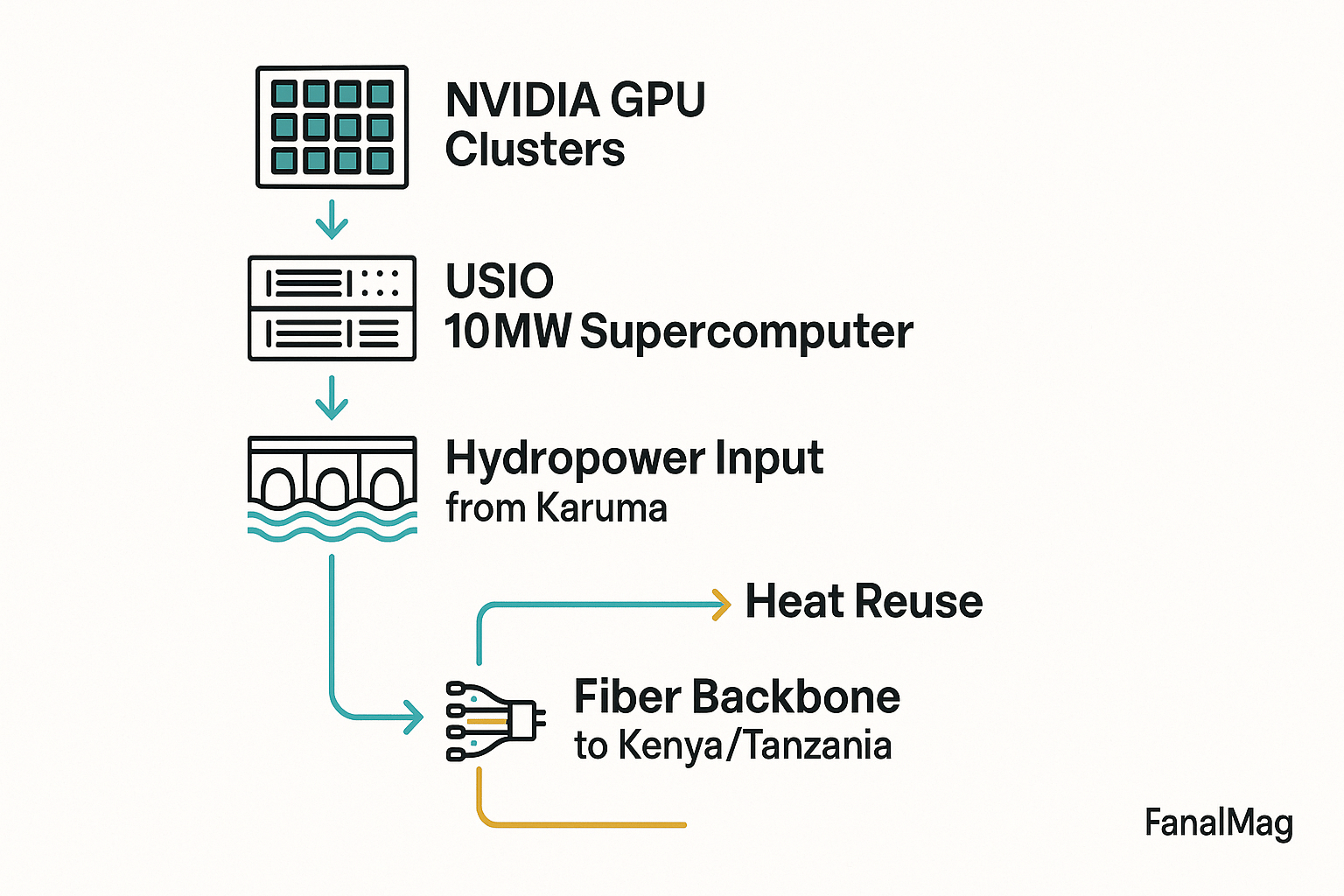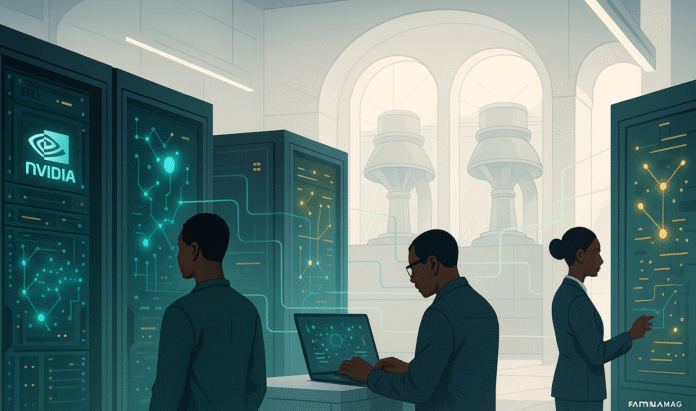The Uganda AI Factory, known officially as the Aeonian Project, marks a turning point for Africa’s digital sovereignty. Powered by NVIDIA GPUs and renewable hydroelectric energy, this facility positions Uganda as a pioneer in sovereign compute infrastructure for Africa.
The government, together with private and international partners, has announced the Aeonian Project, a ground-breaking AI factory powered by renewable energy and equipped with NVIDIA hardware.
The facility aims to reshape how Africa builds, trains, and deploys artificial intelligence — keeping data and computation local, sustainable, and under African control.
What is the Aeonian Project?
Uganda’s AI factory is not just another data centre; it’s designed to be a hyperscale compute hub. Built within the Karuma Hydropower Plant complex, the facility will harness renewable energy to power cutting-edge NVIDIA GPU clusters, enabling the training of next-generation AI models. It represents Uganda’s vision of becoming an AI leader in East Africa.
- The Aeonian Project is a 100-megawatt (MW) hyperscale AI facility to be built inside the Karuma Hydropower Plant complex.
- It will leverage surplus electricity from Karuma, including “pre-transmission” electricity — power that would otherwise be curtailed or underutilised before being sent across the grid.
- The project is backed by NVIDIA, AI infrastructure firm MDCS.AI, and Automation NV (Belgium), along with support from partners including Germany’s GIZ, Finland’s HAUS, and the EU Development Fund.
Timeline & Components
The Aeonian Project will roll out in phases. The first 15 MW AI module and 10 MW USIO supercomputer are expected to go live in 2026, with the whole facility operational by 2028. This stepwise approach lets Uganda scale gradually while testing infrastructure resilience and attracting private-sector innovation.
How the Uganda AI Factory Runs on Renewable Power

- Fully powered by renewable energy from the hydroelectric plant.
- To use natural river water cooling, modular heat reuse, and “smart infrastructure” to minimise energy losses and maximise efficiency.
- A new 2,500 km fibre-optic backbone is planned to connect Uganda to international submarine cables via Kenya and Tanzania, enabling data transfer and global connectivity.
What “sovereign AI” means here
For decades, most African AI workloads have relied on foreign cloud providers in the U.S. and Europe. The Aeonian Project flips that model, keeping data storage, training, and inference on African soil. This creates opportunities for local researchers, startups, and universities to build AI systems tuned to African realities — from languages to healthcare.
- Data processing, training, and inference are all intended to occur mainly on Ugandan soil, rather than being outsourced to foreign cloud providers.
- Local researchers, universities, and developers will gain access to and the ability to build AI models grounded in African data and regional languages.
Why this matters
- Africa has long been underserved in terms of computing infrastructure. Many AI ventures depend on cloud servers in Europe, North America, or Asia. Latency, data sovereignty, cost, and compliance all suffer as a result.
- The Aeonian Project promises to redress that imbalance. By keeping computing closer, Uganda (and, by extension, Africa) can, in theory, innovate faster, more cost-effectively, more securely, and in culturally relevant ways.
- It also aligns with environmental goals: using renewable energy, efficient cooling, and heat reuse helps reduce the carbon footprint.
Key Stakeholders
The Aeonian Project is led by Synectics Technologies, backed by NVIDIA, MDCS.AI, Automation NV, and funded by GIZ, HAUS, and the EU Development Fund. The collaboration bridges Ugandan policy, African talent, and global hardware expertise — an ecosystem approach designed for scalability.
- Synectics Technologies is overseeing the project. Oladele Oyekunle, CEO, has said it’s about “empowering Africa to control its data backbone responsibly, sustainably, and sovereignly.”
- MDCS.AI, Automation NV, and NVIDIA provide the technological backbone
- International funders: GIZ (Germany), HAUS (Finland), EU Development Fund.
Challenges & Risks
Despite the optimism, Uganda faces several hurdles, including managing power reliability, securing skilled talent, ensuring adequate data protection policies, and overcoming global hardware supply chain constraints. Without strong regulatory frameworks and investment in local capacity, the project risks becoming another export pipeline for African compute.
- Power reliability & grid integration: Even though there is surplus power, ensuring a stable supply, managing transmission, and losses, among other factors, will be complex.
- Funding & cost: Such infrastructure is capital-intensive. Cost overruns and delays are likely. Procurement of hardware (GPUs, etc.) must also contend with global supply chain constraints.
- Human capacity: Having the infrastructure is one thing; having enough trained engineers, researchers, DevOps professionals, and people who can manage, optimise, maintain, and secure it is another. Without local capacity building, much of the benefit may still leak away.
- Regulatory/legal issues, including data protection, cross-border data flows, intellectual property, and local policies, must be addressed to support this initiative.
Implications & Possible Outcomes
If successful, Uganda could become the AI hub of East Africa, supplying infrastructure to startups, researchers, and governments across the region. Expect ripple effects — neighbouring countries like Kenya and Rwanda are already exploring similar projects. The race for Africa’s AI sovereignty has begun, and Uganda wants to set the pace.
- If successful, Uganda could become a tech hub for East Africa, exporting AI services, supporting startups, universities, and governments across the region.
- This shift may alter how AI development is conducted in Africa, leading to a reduced dependence on foreign cloud providers, increased local model training, greater AI usage in regional languages, and more relevant datasets.
- The project may spur competition and collaboration: other African countries may accelerate similar efforts, which could lead to a healthier ecosystem (but also risk duplication or fragmentation unless coordinated).
What to Watch Next
- How the first phase (2026) performs: when USIO comes online, what its capacity, uptime, and actual usage will be.
- Whether the promised infrastructure (fibre backbone, cooling, energy reuse) meets expectations and stays on schedule.
- How costs evolve and what pricing structures will be in place for local users (governments, startups, researchers).
- Development of local talent: training programmes, universities, partnerships.
- Policy frameworks around data privacy, sovereignty, and cross-border data transfer.
Conclusion
Uganda’s Aeonian Project is more than just a building full of servers and GPUs. It represents a potential hinge point in Africa’s AI story — between being customers of global AI infrastructure and becoming creators of it, with all the control, responsibility, and risks that entails.
If successful, the Uganda AI Factory could transform Uganda into East Africa’s AI hub, accelerating innovation, reducing dependence on foreign cloud providers, and creating a blueprint for the continent’s sovereign AI future

